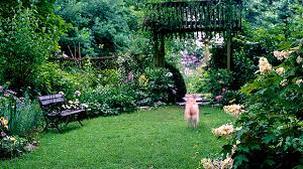|
Ozark Green Thumb BCMG Monthly e-Newsletter |
|
|
 Many gardeners view shade as a challenging situation for growing plants. While some plants do not grow well in low light, numerous others thrive under these conditions. Just as moisture, temperature, and soil conditions may limit plant growth, the amount of shade present may determine which plants will grow successfully. The key is to discover which ones are adapted to the conditions in your yard or garden. Landscapes change their degree of shade over time. As trees and shrubs mature, the landscape receives greater shade. What was once a sunny garden may evolve into a shady one. Analyze the degree of shade in your garden periodically to determine if changes in plant materials may be needed due to increased shade from a maturing landscape. Several characteristics typify shade gardening. In addition to low light levels, plants growing in the shade must compete with shading trees for nutrients and water, and tolerate poor air circulation. The best way to cope with low light levels is to choose plants that do well in less light. Light shade may be described as an area that is shaded but bright. It may be completely shaded for only several hours each day. The sun's rays may be blocked by a wall or building for several hours at midday, but the area is sunny the rest of the day. Light shade may also be found in areas that receive filtered or dappled sunlight for longer periods. Edges of shady gardens or areas under the canopy of solitary, lightly branched trees are typical of filtered sunlight. During the heat of summer, light shade at midday will provide a beneficial cooling effect. Flower and foliage color may be more brilliant when plants are shielded from intense midday sunlight. Partial or medium shade is present when direct sun rays are blocked from an area for most of the day. Many established landscapes have large areas of partial shade, where sections of the yard are shaded by mature trees for much of the day but receive some direct sun early or late in the day. Bright, north-facing exposures may also be classified as medium shade. Full shade lasts all day. Little or no direct sunlight reaches the ground at any time of the day. There may be reflected light from sunnier areas of the yard or off light-colored walls. Dense shade refers to full shade under thick tree canopies or in dense groves of trees. Areas under stairways, decks or covered patios on the north side of the house receive full shade. Keep in mind that light patterns change with the seasons. An area that is in full sun in summer when the sun is high in the sky may have medium shade in spring and fall, when the sun is at a lower angle. Study your garden through the seasons to accurately determine what type of shade is present. Available sunlight may be increased by selective pruning. Removal of lower limbs on large trees may increase light levels significantly. Large shade trees are a valuable resource that in most cases should be preserved. However, removal of diseased, unattractive, or poorly placed trees improves the beauty of your property and increases the light available for plant growth. Take advantage of reflected light, if possible. White or light-colored surfaces reflect more light than dark-colored ones. Light-colored house siding or fences may increase available light to plants. Plants growing in the shade often must also compete with roots of shading trees for nutrients and moisture. Shallow rooted trees such as maples and willows are particularly troublesome. Adding organic matter to shade garden soils will help. Most woodland species are accustomed to growing in soils rich in leaf litter compost. Raking and removal of leaves each fall in the typical landscape disrupts this natural nutrient recycling process. If leaves are not removed, they can mat down and smother shade garden plants, but shredded leaves can be safely applied as a mulch. Another option is to compost the leaves first, and apply the compost in core aeration holes or in small pockets dug into the garden. Do not haul in several inches of compost-rich amendment to till into soil under shade trees. Some species, such as oaks, are extremely sensitive to changes in soil depth within their root zone. In addition, tillage will damage many of the tree's roots, starting a decline from which the tree may never recover. If the gardener is patient, earthworms will eventually incorporate surface-applied organic matter. Organic matter loosens heavy clay soils, improving drainage. In sandy soils, organic matter will increase the water-holding capacity. As organic matter breaks down, it also releases nutrients to the plants. Roots competing for limited surface water may cause shade gardens to dry out more quickly than sunny sites during extended dry periods. Some shade-tolerant plants are adapted to low moisture situations, while others require moist shade. Provide water according to the plants' needs. Branches or walls that cast shade also block air movement. Poor air circulation coupled with lower light levels means foliage of plants stays wet longer in the shade than in sunny areas. Most plant disease problems are worse under these conditions. Prevent disease problems by selecting disease-resistant varieties when available. Space plants farther apart in the shade to allow more air movement around each individual plant. Water with soaker hoses or drip irrigation systems to avoid wetting the foliage. Removal of lower tree limbs may funnel breezes underneath the tree canopy, thereby improving air circulation. Bright, bold colors are less common in shade tolerant plants than in sun-loving ones. Flowers are usually produced less abundantly in the shade as well. For these reasons, shade gardens are often more subtle and restful than sunny ones. Plant textures, forms, and slight color differences become more important elements of the design. Texture has many aspects. Large-leaved plants such as hostas have a coarse texture, while finely divided fern fronds create a fine texture. Strong contrasts in texture accentuate their differences. Use strong textural contrasts only where emphasis is needed. Pyramidal or upright, columnar plant forms serve best as accents in the shade. Rounded, weeping, or spreading forms create a more spacious effect and can be used more liberally in the design. Glossy leaves have more impact than dull or velvety ones. Variegated or yellow-green foliage is evident in the shade more than solid green or blue-green foliage. Light colors — white, cream, yellow and pastel pink — stand out in the shade. Deep reds, blues and purples may fade into the shade unless set off by a contrasting lighter color. To emphasize plantings in the shade, concentrate on plants with light-colored flowers or foliage. Almost all food crops grow best in sunny locations. Not only do they need full sunlight for good growth, few tolerate root competition from trees. Cool-season salad vegetables such as lettuce, spinach and radishes may benefit from light shading through the heat of the summer. Beans, beets, broccoli, cabbage, kohlrabi, peas, potatoes, rhubarb and turnips will grow in light shade but not produce as large a crop as plants growing in full sun. Currants and gooseberries are fruits which tolerate medium shade and still produce a crop. Bramble fruits such as blackberries and raspberries grow in light shade, but yields will be reduced. Source: Christoper J. Starbuck
Department of Horticulture University of Missouri Extension
7 Comments
4/8/2021 09:36:35 am
I want to make sure that my garden grows well. It's in a rather shaded area, so it makes sense that it might need the extra help! I'll be sure to look into different kinds of growth medium to ensure that I assist it as much as I can.
Reply
12/12/2021 01:43:11 am
To emphasize plantings in the shade, concentrate on plants with light-colored flowers or foliage.
Reply
12/30/2021 01:55:48 am
a professional auto broker needs to get it right in most cases. Some other steps to fully round up an entire car importation process are not part of this post, like evaluation and transportation within Germany or shipment.
Reply
7/7/2022 03:27:45 pm
I am very happy to get this valuable information. success to you all.
Reply
Leave a Reply. |
Archives
April 2022
|
|
